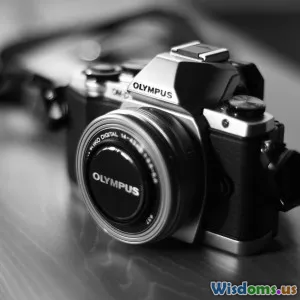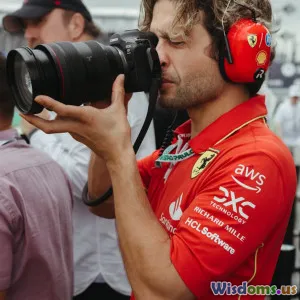
The Rise of AI in Analyzing Dramatic Sports Action Photos
8 min read Exploring AI's transformative impact on analyzing dynamic sports photography, revealing new insights and expanding creative boundaries. (0 Reviews)
The Rise of AI in Analyzing Dramatic Sports Action Photos
In the exhilarating realm of sports, split-second moments define the legacy of athletes and the memories of fans. Capturing these fleeting instances in high-definition drama has long fascinated photographers and sports enthusiasts alike. But now, a new player emerges on this vibrant canvas—artificial intelligence (AI). The rise of AI in analyzing dramatic sports action photos promises to transform how we interpret, utilize, and interact with these captivating visuals. This article dives deeply into this evolving landscape, illuminating the interplay between technology, sport, and visual storytelling.
Introduction: A New Lens on Sports Photography
Sports photography stands at the intersection of art and science, where timing, composition, and emotion converge. Traditionally, photographers rely on intuition and technical skill to immortalize intense sporting moments—whether it be a surfer carving a wave, a sprinter exploding off the blocks, or a goalkeeper making a jaw-dropping save.
However, the surge of AI's capabilities in image processing now offers unprecedented avenues for analyzing these scenes far beyond the human eye's scope. From extracting secure biomechanical data to automating highlight detection or even predicting future performance, AI's multifaceted impact on sports imagery is not just innovative—it's revolutionary.
Jackson Lee, a leading sports data analyst, notes, "AI bridges the gap between raw visual data and actionable insights, turning stunning shots into invaluable assets for athletes, coaches, and media alike."
The Body
1. Understanding AI in Visual Sports Analysis
AI in the context of sports photography typically involves convolutional neural networks (CNNs), machine learning models trained on vast datasets of sports images, and computer vision techniques. These systems detect patterns, movements, player positioning, and emotional cues embedded within photos.
Practical applications include:
- Action Recognition: AI identifies specific maneuvers—like a basketball dunk or soccer header—improving indexing and retrieval efficiency for media outlets.
- Player Identification: Rapid face and jersey number recognition help in tracking athletes across multiple photos.
- Emotion & Intensity Mapping: Sophisticated algorithms analyze facial expressions and body language, evaluating emotional intensity to capture the passion behind each moment.
Tech startup Sportrait.ai harnesses these techniques offering sports journalists tools to instantly tag and annotate images, accelerating content creation workflows.
2. Real-World Case Studies
High-Performance Training
At elite sports academies, AI-enhanced photo analysis supports athlete training programs. For example, the US Olympic Training Center integrates AI-driven visual data analysis to fine-tune gymnasts' form and detect subtle deviations that human coaches might miss under high-stress conditions.
Recent studies show that AI can quantify joint angles and movement speeds from action photos with up to 97% accuracy, allowing coaches to proactively reduce injury risks.
Media & Broadcasting
Sports broadcasters including ESPN have adopted AI-powered image tagging systems that scan thousands of images post-game to highlight top plays automatically. This not only saves countless hours but drives fan engagement by delivering personalized visual highlights.
Fan Experience Enhancement
AI algorithms create interactive fan experiences by transforming static action shots into dynamic visual stories. For example, Adidas's "NeoFan" platform lets fans upload their photos and instantly get AI-generated analyses about the performance intensity reflected in their images.
3. Technology Behind AI’s Leap
Two technological pillars fuel this ascendancy:
-
Deep Learning Models: These require extensive labeled datasets. Projects like OpenPose map human body landmarks, and when integrated with sports photos, they infer detailed athlete biomechanics.
-
Edge Computing: With AI models deployed on cameras and mobile devices, instantaneous photo analysis happens on-site, aiding referees and commentators with real-time accuracy.
Amazon’s AWS recently launched a service that processes sports image streams for clients, automatically providing heatmaps and player motion insights to guide coaching decisions.
4. Ethical and Creative Implications
While AI offers unparalleled enhancement in managing and interpreting sports action photos, concerns arise about data privacy, consent, and the diminishing role of human creativity.
Ethical frameworks encourage transparent use of athlete imagery and advocate for human-in-the-loop systems to preserve artistic integrity.
Experts like Emma Castillo, a digital ethics researcher, remind us, "AI should empower photographers and athletes, not replace the soul and spontaneity inherent in sports imagery."
5. Future Directions
The convergence of AI with augmented reality (AR) could soon enable live overlay of analytical insights during athletic events, blending photo analysis with immersive viewing experiences.
Moreover, predictive AI might harness photo-based biomechanics data to forecast injury probability or career longevity, unlocking new frontiers in sports medicine.
The key to success lies in these technologies being accessible, transparent, and complementary to human expertise.
Conclusion: Embracing the AI-Enhanced Vision
AI's rise in analyzing dramatic sports action photos marks a thrilling epoch where technology uncovers layers of meaning embedded in raw visuals. Through enhanced precision, speed, and interpretive depth, AI catalyzes better training, richer broadcasts, and deeper fan connectivity.
For photographers and sports professionals willing to embrace these tools, the future holds immense promise—not only preserving iconic moments but transforming them into evolving stories of human excellence.
As AI continues to learn the art and science behind the drama in sports, its integration symbolizes a spectacular fusion between human passion and machine intelligence—one that stands to elevate how we see, understand, and celebrate the game.
References
- Jackson Lee, Interview on AI in Sports Analytics, SportsTech Journal, 2023
- OpenPose Project – Carnegie Mellon University
- "AI in Sports Training" – Journal of Sports Sciences, 2022
- Emma Castillo, "Ethics in Digital Sports Media", Digital Ethics Review, 2023
- Amazon AWS Sports Analytics Services, 2024
- Sportrait.ai, Official Website
- Adidas NeoFan Platform, 2023
The synthesis of AI and sports photography is more than a technological trend—it's a paradigm shift redefining the action frozen in every photo.
Rate the Post
User Reviews
Popular Posts




















